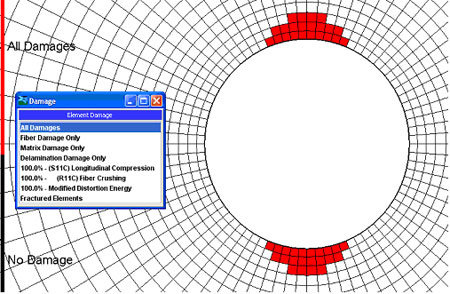Manufacturing Defects
複合材進展性損傷/破壊評価解析ソフトGENOA/MCQ -機能情報
GENOA-Composite Manufacturing Defects
Common composite manufacturing defects include void of different shapes and sizes, different location of void (i.e. within the matrix or in between two adjacent plies). Other forms of manufacturing defects in composite laminates result from hand-Layup and automated fiber placement processes, which can cause intra-ply overlap resulting in fiber waviness and/or resin rich pocket gap defects. The presence of gaps containing resin rich pockets and/or wavy fibers affects the performance of laminate modulus and strength properties. It is important to account for manufacturing defects and their variability on material and structural response.
Challenge
Modeling manufacturing defects by means of finite element analysis (FEA) is impractical. The modeling of voids and fiber waviness is very time consuming. Additionally, use of FEA will introduce other challenges as some voids, when modeled, can cause stress concentration issues. Micro-mechanics based approach is the most efficient approach to model and analyze effects from composite manufacturing defects.
Implications
Not accounting for the deterministic and probabilistic nature of composite manufacturing defects can increase the risk associated with the use of composite sin critical structures such as those used in aerospace. For example, manufacturing defects can reduce the stability of composite structures and reduce their impact resistance. To account for such defects, designers tend to reduce the strength allowables used in design, resulting in increased weight and cost.
How we address it
AlphaSTAR devised a numerical approach combining multi-scale progressive failure analysis to predict the in-situ degraded ply properties containing voids of different sizes and shapes and gaps.
GENOA’s PFA module allows the insertion of manufacturing defects in composite laminates for use in progressive failure analysis.
Benefits Provided
- Simplified practical approach for modeling of manufacturing defects
- Determination of equivalent ply properties with defects for use in multi-scale progressive failure analysis
- Capture damage and fracture evolution in presence of manufacturing defects
- Determine loss in strength and stiffness due to manufacturing defects
- Reduce number of tests by validating coupons tests with defects then use approach to assess effects at component level
Testimonials
AlphaSTAR assessed risks associated with composite manufacturing defects for aerospace and automotive industries.
Reference
J. Sawicki, P. J. Minguet, “The Effect of Interply Overlaps and Gaps upon the Compression Strength of Composite Laminates” 39th AIAA/SDM Conference Paper, AIAA-98-1786, Long Beach, CA, 1998

Damage marked in red in open hole laminate under compression with gap defects obtained from multi-scale PFA

